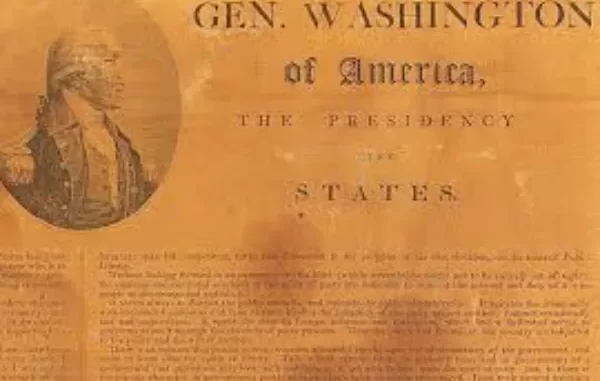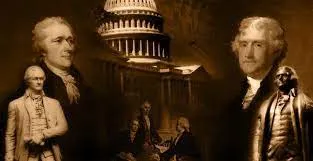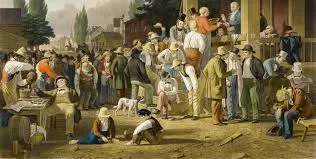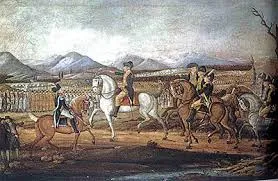
The history of political parties in the United States has been shaped by the country’s unique form of government and the development of the nation. Political parties in the United States have evolved since the country’s founding and have had a major impact on the country’s history and politics. The development of the two-party system in the United States has been a major factor in the success of the nation’s democracy.
This article will provide an overview of the history of political parties in the United States, from the Founding Fathers to the present day. It will examine the role of political parties in the development of the United States, the various types of political parties, and the impact of the two-party system on the nation’s politics.
From Federalists to Whigs: Tracing the Evolution of Political Parties in the U.S.
The history of political parties in the United States can be traced back to the Founding Fathers. The first two major parties were the Federalists and the Democratic-Republicans. The Federalists, led by Alexander Hamilton and John Adams, believed in a strong centralized government and supported mercantilism and pro-business policies. The Democratic-Republicans, led by Thomas Jefferson, favored states’ rights and supported agrarian policies.
The Democratic-Republicans evolved into the Democratic Party in the 1820s, with Andrew Jackson at the helm. The Jacksonian Democrats championed states’ rights and sought to expand democracy through the removal of property qualifications for voting. This period also saw the emergence of the Whig Party, led by Henry Clay and Daniel Webster. The Whigs sought to protect the interests of industrialists and financiers and were opposed to Jackson’s populist policies.

The Civil War saw the dissolution of the Whig Party and the rise of the Republican Party. Founded in 1854, the Republicans were staunchly opposed to slavery and sought to create a strong centralized government. The Republican Party was led by Abraham Lincoln and later by Ulysses S. Grant.
In the late 19th century, the Populist Party emerged, advocating for the rights of farmers and laborers. The Populists sought to combat the power of large corporations and sought reforms such as a graduated income tax and an eight-hour workday. Though they had some success in the South, the Populists eventually dissolved in the early 20th century.
Today, there are two major political parties in the United States: the Democratic Party and the Republican Party. Though they have evolved over time, the two parties have retained many of the core principles of their predecessors. The Democratic Party still advocates for states’ rights and progressive reforms while the Republican Party still champions a strong centralized government and pro-business policies.
The Founding Fathers and the Birth of Political Parties in America
The Founding Fathers of the United States of America were among the first to recognize the need for the formation of political parties. Although the concept of political parties had existed in other nations for some time, it was the Founding Fathers who first understood the importance of political parties in the American context. It was their vision that created the framework for the two-party system that continues to dominate American politics to this day.
The Founding Fathers first began discussing the concept of political parties in the 1780s, shortly after the ratification of the Constitution. At the time, many of the Founding Fathers believed that political parties would help to ensure the stability of the American government. Political parties, they reasoned, would provide an outlet for citizens to express their political preferences and to support their chosen candidates. In addition, political parties would help to ensure that the government responded to the needs of the people, as opposed to special interests.
The first political parties were established in the 1790s, shortly after the first Congress convened. The two leading political parties of the era, the Federalists and the Democratic-Republicans, were founded by two of the most influential Founding Fathers: Alexander Hamilton and Thomas Jefferson. Hamilton’s Federalists championed the interests of the wealthy and powerful, while Jefferson’s Democratic-Republicans sought to empower the “common man.”
The Founding Fathers’ vision of political parties proved to be as enduring as their vision of the American government. Despite numerous changes in power, the two-party system that Hamilton and Jefferson established remains in place today. This is a testament to the foresight of the Founding Fathers and their belief that political parties would be essential in ensuring the stability and success of the American government.
From the Rise of Jacksonian Democracy to the Civil War and Beyond
The period from the rise of Andrew Jackson’s presidency in 1828 to the Civil War in 1861 was an important and turbulent time in American history. This period saw the emergence of Jacksonian Democracy, a new political movement that sought to empower ordinary citizens and limit the power of the federal government. It also saw the growth of the abolitionist movement, which sought to end slavery in the United States. Finally, it saw the expansion of the country through Manifest Destiny as settlers moved westward and conflicts with Native American tribes increased.

Jacksonian Democracy, or Jacksonianism, was a major political movement that sought to empower ordinary citizens and limit the power of the federal government. Jackson’s presidency ushered in a period of increased democracy in the United States, with more citizens eligible to vote and more states allowing popular voting for president.
Jackson also sought to reduce the power of the federal government by dismantling the Second Bank of the United States and vetoing the re-chartering of the Bank of the United States. In addition, Jackson’s veto of the Maysville Road bill demonstrated his commitment to states’ rights and limited the power of the federal government.
The abolitionist movement also grew during this period, as more Americans began to oppose slavery and call for its immediate and total abolition. This movement was led by figures such as William Lloyd Garrison, who founded the Anti-Slavery Society in 1831, and Harriet Beecher Stowe, who wrote the widely-read novel Uncle Tom’s Cabin in
The movement was met with fierce resistance, and was one of the primary causes of the Civil War. Finally, this period saw the expansion of the United States through Manifest Destiny. This ideology held that it was the United States’ destiny to expand from coast to coast, and this expansion was enabled by the Louisiana Purchase, the Oregon Treaty, and the Mexican-American War. This period also saw increased conflict with Native American tribes, as settlers moved westward and sought to take their land. The Indian Removal Act of 1830 forced many Native Americans to move to reservations in the West, leading to further land loss and displacement for many tribes.
The Emergence of the Two-Party System in the Late 19th Century
In the late 19th century, the United States saw the emergence of a two-party system. This system was a result of a number of factors, including the growing influence of political machines, the development of political ideologies, and the increasing polarization of voters.
The political machines of the late 19th century were powerful organizations run by local leaders who would reward their supporters with patronage jobs and political favors. These machines were often controlled by a single party and gained a great deal of influence over the local government. This led to a situation where a single party was dominant in a particular area, and this domination would eventually spread to the national level.
At the same time, political ideologies began to emerge. Political groups such as the Populists and the Progressives sought to challenge the status quo and promote their ideas of reform. These groups began to coalesce around a particular party, and this further solidified the two-party system.

Finally, the increasing polarization of voters also contributed to the emergence of the two-party system. As the country entered the 20th century, more and more people were identifying strongly with one party or the other. This led to more and more people voting for the same party, which further strengthened the two-party system.
The emergence of the two-party system in the late 19th century was a result of a number of different factors. From the powerful influence of political machines to the increasing polarization of voters, the two-party system quickly became the standard in the United States.
The Impact of the Progressive Movement on Political Parties in the U.S.
The Progressive Movement, which began in the late 19th century, was a period of political, economic, and social reform in the United States. This period was marked by a number of reforms that sought to address the social and economic inequalities of the day. The Progressive Movement had a profound impact on the political parties of the United States.
The Progressive Movement had a major impact on the Republican Party. Before the Progressive Movement, the Republican Party was largely associated with corporate interests and the wealthy. However, during the Progressive Era, the Republican Party shifted away from this image and began to embrace the progressive ideals of social and economic reform. The Republican Party embraced the concept of a strong federal government, supported labor unions, and pushed for greater regulation of the economy.
The Progressive Movement also had an influence on the Democratic Party. While the Democratic Party had traditionally been associated with labor unions and the working class, the Progressive Movement brought about a shift in the party’s platform. The Democratic Party began to embrace progressive ideals such as government intervention in the economy, labor rights, and social reform.
In addition to the major parties, the Progressive Movement also had an influence on the emergence of third parties. During the Progressive Era, several third parties emerged in the United States, including the Progressive Party, the Socialist Party, and the Farmer-Labor Party. These third parties were largely progressive in nature and sought to challenge the status quo and push for greater social and economic reform.
The Progressive Movement had a profound impact on the political parties of the United States. The Republican Party shifted from its corporate roots and embraced progressive ideals, while the Democratic Party embraced a more progressive platform. Additionally, the Progressive Era saw the emergence of several third parties that sought to challenge the existing political system. As a result, the Progressive Movement had a lasting impact on the American political landscape.
The history of political parties in the United States is a long and complex one. From the emergence of the first two-party system in the late 1700s to the current two-party system, the history of American political parties has been marked by shifts in party platforms, successes and failures of individual parties, and the rise and fall of various third-party movements. Despite these changes, the two-party system has remained largely intact throughout United States history, and it remains the dominant feature of the American political landscape today.






Leave a Reply